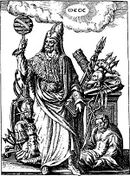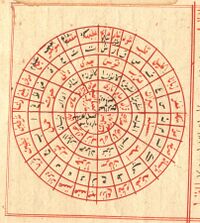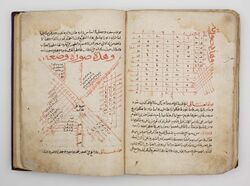Biography:Ahmad al-Buni
thumb|upright|Shams al-Ma'arif al-Kubra, a manuscript copy, beginning of 17th century
| Part of a series on |
| Hermeticism |
|---|
 |
| Mythology |
| Hermetica |
|
"Three Parts of the Wisdom of the Whole Universe" |
| Movements |
| Orders |
| Topics |
| People |
Sharaf al-Din or Shihab al-Din or Muḥyi al-Din Abu al-Abbas Aḥmad ibn Ali ibn Yusuf al-Qurashi al-Sufi, better known as Ahmad al-Buni (Arabic: أحمد البوني, d. 1225), was a mathematician and philosopher and a well known Sufi. Very little is known about him. His writings deal with the esoteric value of letters and topics relating to mathematics, sihr (sorcery) and spirituality.[1][2] Born in Buna (present-day Annaba, Algeria), al-Buni lived in Egypt and learned from many eminent Sufi masters of his time.[3]
A contemporary of Ibn Arabi,[4] he is best known for writing one of the most important books of his era; the Shams al-Ma'arif, a book that is still regarded as the foremost occult text on talismans and divination.
Contributions
Theurgy
Instead of sihr (Sorcery), this kind of magic was called Ilm al-Hikmah (Knowledge of the Wisdom), Ilm al-simiyah (Study of the Divine Names) and Ruhaniyat (Spirituality). Most of the so-called mujarrabât ("time-tested methods") books on sorcery in the Muslim world are simplified excerpts from the Shams al-ma`ârif.[5] The book remains the seminal work on Theurgy and esoteric arts to this day.
Mathematics and science
In c. 1200, Ahmad al-Buni showed how to construct magic squares using a simple bordering technique, but he may not have discovered the method himself. Al-Buni wrote about Latin squares and constructed, for example, 4 x 4 Latin squares using letters from one of the 99 names of Allah. His works on traditional healing remains a point of reference among Yoruba Muslim healers in Nigeria and other areas of the Muslim world.[6]
Influence
His work is said to have influenced the Hurufis and the New Lettrist International.[7]
Denis MacEoin in a 1985 article in Studia Iranica said that Al-Buni may also have indirectly influenced the late Shi'i movement of Babism. MacEoin said that Babis made widespread use of talismans and magical letters.[8]
Writings
- Shams al-Maʿārif al-Kubrā[9] (The Great Sun of Gnosis), Cairo, 1928.
- Sharḥ Ism Allāh al-aʿẓam fī al-rūḥānī, printed in 1357 AH or in Egypt al-Maṭbaʿa al-Maḥmudiyya al-Tujjariyya bi'l-Azhar.
- Kabs al-iktidā, Oriental Manuscripts in Durham University Library.
- Berhatiah, Ancient Magick Conjuration Of Power.
- Treatise on the Magical Uses of the Ninety-nine Names of God in the Khalili Collection of Islamic Art[10]
References
- ↑ B. G. Martin, Muslim Brotherhoods in Nineteenth-Century Africa, Cambridge University Press, 2003, p.149
- ↑ Dietrich, A., “al-Būnī”, in: Encyclopaedia of Islam, Second Edition, Edited by: P. Bearman, Th. Bianquis, C.E. Bosworth, E. van Donzel, W.P. Heinrichs, p. 149
- ↑ By C. J. Bleeker, G. Widengren, Historia Religionum, Volume 2 Religions of the Present, p.156,
- ↑ Vincent J. Cornell, Realm of the Saint: Power and Authority in Moroccan Sufism, University of Texas Press, 1998, p. 221
- ↑ Martin van Bruinessen, "Global and local in Indonesian Islam", Southeast Asian Studies (Kyoto) vol. 37, no.2 (1999), 46-63
- ↑ Diagnosis through rosary and sand: Islamic elements in the healing custom of the Yoruba (Nigeria). Sanni A. Lagos State University, Nigeria
- ↑ Shams al-Ma'arif al-Kubra ۞ The Sun of Great Knowledge.
- ↑ Denis MacEoin, ‘Nineteenth-Century Babi Talismans’, Studia Iranica 14:1 (1985), pp.77-98.]
- ↑ "Shams ul Maarif ul Kubra Urdu, شمس المعارف الکبریٰ, اردو, لطائف العوارف". https://quranwahadith.com/product/shams-ul-maarif-ul-kubra-urdu/.
- ↑ Rogers, J. M. (2008). The arts of Islam : treasures from the Nasser D. Khalili collection (Revised and expanded ed.). Abu Dhabi: Tourism Development & Investment Company (TDIC). p. 170. OCLC 455121277.
Notes
- Edgar W. Francis, Mapping the Boundaries between Magic. The Names of God in the Writings of Ahmad ibn Ali al-Buni
External links
 |



